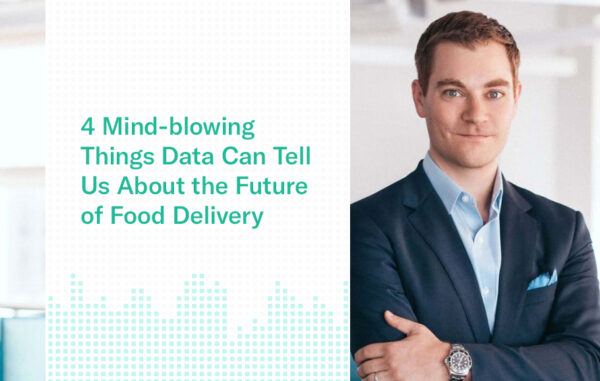Technology has made it easier than ever to get restaurant-made food on demand. The foodservice industry is still rapidly evolving and learning to leverage customer data analytics to better cater to the ways we want our food.
To find out what the future of foodservice will look like, we sat down with Noah Glass, the founder and CEO of Olo. His company uses data-driven decision making to power the order-ahead technology for 200 restaurant brands, including Chipotle, sweetgreen, and Shake Shack.
To hear more of our conversation, check out our podcast episode featuring Glass on Deciding by Data.
1. Your food delivery apps already know your weird ordering habits.
Remember that one time you indulged in some nachos along with your standard salad order? Well, your food ordering app does. Glass said it’s easy to tell when someone orders a guilty treat. Most times, customers will reorder an unhealthy snack from their previous purchases, rather than favoriting the item.
“I think there’s a psychological thing in there where, I don’t want to acknowledge that I’m ever going to get the unhealthy thing again,” Glass said. “It’s just a one-timer. But the convenience of going back into my order history and clicking once to reorder it is great, because I actually do wind up wanting the same thing.”
The time of year, or even time of the week, can affect ordering habits. Glass said people tend to order more healthy items around the beginning of the year when they are holding fast to New Year Resolutions, and more unhealthy items toward the end of the year. But even throughout a single week, people often start off with healthy habits, and cave to cravings by the weekend.
2. Delivery is changing the game entirely.
The convenience of not having to step out of your door to have a meal is spreading outside of major cities. The global food delivery market was valued at $114 billion in 2016 and is expected to grow by 8.5 percent per year according to research firm Euromonitor International, The Chicago Tribune reported.
But restaurants will likely not be the only ones to cash in on the growing delivery space. Grocery and convenience stores have caught onto the potential value as well, which will mean more competition for restaurants.
“I think the trend towards off-premise consumption is a good thing for restaurants, and that’s where you see the restaurant industry growing, and the traditional grocery industry shrinking,” he said. “I think that the trend towards delivery is potentially not a great thing for restaurants, really because of the cost of delivery and the fact that their profits are getting squeezed out. But that’s separate from the new competition.”
3. Data-driven restaurants will resemble kitchens more than dining rooms.
These days, only 38 percent of restaurant sales are eaten inside of the actual restaurant, Glass said. With more and more restaurant-prepared food being eaten outside of stores, Glass said restaurants will likely downsize to their most essential parts.
“I think restaurants that are really great environments and great social settings are going to do well,” Glass said. “I think there are a lot of restaurants that are really just kitchens, and don’t need to have a dining room, or need to have a smaller dining room now.” Some restaurants are already “turning themselves into ghost kitchens [restaurants that only deliver] before it can happen to them.
4. It won’t be long before data can help build the ideal restaurant
We asked Glass if Olo had the data to build the perfect menu — one destined to satisfy customer cravings. Legal restrictions aside, he responded, “absolutely.”
“I think this is not just a thought experiment. I think that this is maybe the next chapter in what’s going to happen in food delivery,” Glass said, adding that ghost kitchens will become the way of the future. He argued that ghost kitchens will be able to hone in on the most popular items by the ZIP code they are delivered to, and a variety of other factors, at a much lower operating cost than they would if they maintained a dining space. As data becomes a larger part of how restaurants acquire and retain customers, they are likely to continue slimming down their operations based on tested ways to optimize profits.
Want to find out how data can drive your business into the future? Request a demo of Indicative today!
